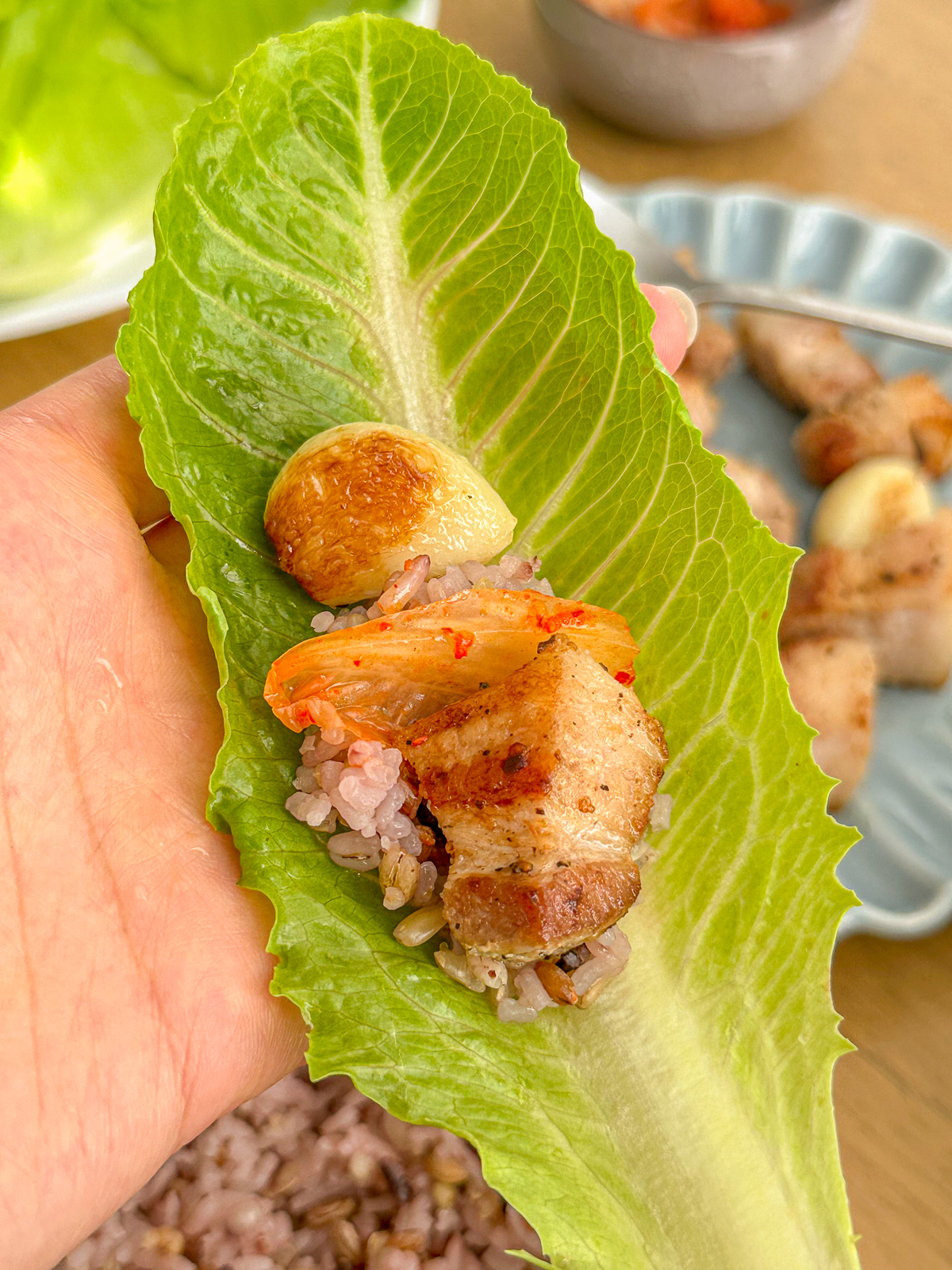Authentic Korean meals start with the right sauces and cooking techniques to ensure the best flavor! Let me show you the basics on How to Make Authentic Korean Meals at Home whether you’re an expert cook or a newbie.

🔍 Summary: To make authentic Korean meals at home!
- My background: I’ve been a recipe developer/blogger for East Asian cooking for 4+ years and I have been told my Korean dishes taste authentic and delicious. I learned how to make Korean dishes online (just like you!) and I have traveled to Korea to taste test the differences. I have to say that my dishes taste just like the ones in Korea as well as Los Angeles Koreatown (food known to be better than Korea itself!).
- Authentic Korean ingredients & sauces to buy for a delicious meal! A good Korean meal starts with authentic flavors from RIGHT Korean pepper paste, gochugaru, soy sauce and soybean pastes.
- Authentic Korean dishes include anything from stews, stir-fries, and Korean banchan (side dishes), all easy to make! I’ll show you which stews go well with what meats!
Jump to:
Guide to Korean Meals
In this blog post, you’ll find the ultimate guide on how to make authentic Korean meals right in your own kitchen. I’m starting with a simple Korean grocery list to ensure the flavor tastes like it’s made from a Korean family. With the right Korean ingredients, you can make delicious recipes (I listed them below) especially if you haven’t cooked Korean food before.
Best Korean Sauces & Ingredients to Buy
In order to have authentic flavor, the right Korean ingredients are needed to make the dish. These ingredients are all available at Korean grocery stores like H-Mart and Zion Market. If you don’t have a large Korean grocery store near you, I linked the ingredients on Amazon.

- Gochujang (fermented Korean red chili paste) – is made from Korean chili peppers, fermented soybeans, glutinous rice, and salt. The paste is thick and sticky which adds a spicy, salty and sweet flavor to dipping sauces (like ssamjang), stews and dishes like bibimbap and tteokbokki.
- Gochugaru (Korean red chili powder) – Used for seasoning and adding spice to dishes such as kimchi and stews. Sun-dried Korean chili peppers are usually grounded in a powder like form without seeds, which is different from red chili flakes you see in Italian or Chinese cuisine.
- Doenjang (fermented soybean paste) – tastes extra salty, funky (from the fermented soybeans), and a little sweet. This Korean paste is similar to the Japanese miso paste, but has a chunkier texture. Doenjang is a key ingredient to flavoring soups and stews like doenjang jjigae.
- Anchovy Broth – Made from dried fish, kombu, dried shrimp, and shiitake mushrooms. The broth is used in many stews like Korean Soft Tofu Soup, and Kimchi Stew. I added a photo of the one I like to use below!
- Kimchi – is a fermented vegetable usually made from spicy napa cabbage & radish. The kimchi tastes a little sour and spicy from the gochugaru (Korean red chili powder). This is used commonly in lots of stews, stir fries, and as a side dish during meals. You can buy kimchi at the refrigerated section of the Korean grocery store, sometimes they have it at Western stores (like Whole Foods) too, but I find the kimchi too sour (meaning too fermented).
- Sesame oil and seeds – Gives a nutty fragrant flavor and the sesame oil is used at the end of stir fries and marinating vegetables for banchan. I like to use the Kadoya brand with the yellow cap for the most authentic flavor. Also available in all Korean or Asian grocery stores.
If you’re looking for the most tastiest Korean grocery items, check out my blog post Must Get Items at Korean Grocery Stores (H-Mart)
Types of Korean Dishes

Korean cuisine has a large variety of small dishes, soups, and grilled meats—usually served together. If you’ve been to a Korean restaurant, the meal usually comes with one main dish (grilled meat or fish) and a bunch of smaller side dishes called banchan. Every meal is well-balanced with fiber, protein, and carbs—usually a feast!
With every meal, there is always kimchi as a side dish (banchan). Kimchi can be fermented napa cabbage, radish, cucumber, mustard greens, and more (options are endless!). If you love kimchi, I’ve got plenty of recipes for you to try! From Kimchi Cheese Rice Balls and One Pot Kimchi Fried Rice With Spam to quick noodles like Kimchi Udon, or hearty classics like Kimchi Soup (Kimchi Jjigae) and Dubu Kimchi, there’s something to satisfy every craving!
In the next section, I narrowed down the different types of Korean dishes (banchan, soups/stews, grilled meat, and rice & noodle) so you can make a Korean feast at Home!
Banchan
Banchan (반찬) are the small side dishes served alongside Korean meals — such as kimchi, marinated vegetables, and kimchi pancakes! Since Korean meals are served family style, the banchan is meant to be shared with the table and complement the meat and rice.
Steamed egg – soft and silky egg is served as a protein side dish.

Japchae – Stir-fried glass noodles with vegetables and meat, seasoned with soy sauce and sesame oil. You’ll love making this Easy & Quick Japchae (Korean Glass Noodle Stir Fry)

Soups/Stews
Korean soups and stews (guk, tang, and jjigae) are comforting, flavorful dishes that are the star of the Korean meals. The broth light, clear broths to rich, spicy stews, they showcase Korea’s love for deep, slow-cooked flavors and are often enjoyed with rice and side dishes (banchan) for a complete meal.
Tuna Kimchi Jjigae (Kimchi Stew) – A flavorful hearty Korean stew made with kimchi, tuna, tofu, and vegetables. It is an easy, quick way to turn leftover kimchi into a delicious meal.

Sundubu Jjigae – A silky tofu stew, usually spicy and finished with a fresh egg cracked right into the hot bowl. Check out my Korean Spicy Soft Tofu Stew – Sundubu Jjigae!

Doenjang Jjigae – Soybean paste stew made with doenjang, vegetables, tofu, and sometimes seafood or meat, offering a deep, savory flavor. Here’s my Doenjang Jjigae (Korean Fermented Soybean Paste Stew)

Easy Ox Bone Soup – Super creamy and fragrant Korean Ox Bone Soup (Seolleongtang) recipe in under 20 minutes. The clear bone broth is also packed with lots of collagen, protein and nutrients that tastes delicious with kimchi radish!

Grilled Meat
Korean grilled meats are usually marinated (with gochujang) or seasoned meats (can be salt and pepper) like beef, pork, or chicken grilled right at the table or stir fried and placed on a hot plate! Known for their smoky aroma and flavorful marinades, wrap the grilled meat in lettuce with ssamjang and enjoyed with fresh banchan!
Samgyeopsal – Pork belly slices grilled at the table and enjoyed with dipping sauces, lettuce wraps, and plenty of side dishes. This is too good to skip: Korean Pork Belly BBQ (Samgyeopsal). If you want to try Korean BBQ at home but not sure where to start, check out How to Make Korean BBQ at Home.

Bulgogi – Marinated beef slices grilled or stir-fried, offering a sweet and savory flavor profile. Check out my pork version: Korean Pork Bulgogi

Galbi – Beef short ribs marinated in a soy-based sauce with garlic, pear, and sugar, then grilled for a rich, savory-sweet flavor. Don’t miss the savory & sweet from LA Galbi (Korean Marinated Short Ribs) or Air Fryer Beef Short Ribs!

Rice & Noodle
Rice and noodles go perfectly with Korean stews and grilled meat! Usually fried rice is eaten at the end for Korean BBQ or cold noodles are eaten with the hot meat. These dishes below are super flavorful and can be a standalone meal on it’s own!

Easy Kimchi Fried Rice – 15 minutes – A staple Korean dish you can make in just 15 minutes, using leftover rice, fermented kimchi, and gochujang for tangy, bold flavor.
Tteokbokki (Spicy Rice Cakes): Chewy rice cakes in a bold, spicy-sweet gochujang sauce. This Rose Tteokbokki (with Mala Sauce) is a must-try!

Kimchi Bibim Guksu (Korean Spicy Cold Noodles) – A refreshing Korean cold noodle dish with spicy, sweet, tangy sauce and kimchi, perfect for warm days.

Bibimbap – A mixed rice dish topped with various vegetables, a fried egg, and gochujang. Here is my Easy One Pot Bibimbap (Made in Rice Cooker)

If you’re interested, you can explore more delicious Korean food recipes at Authentic Easy Korean Recipes and try them at home!
Korean Meal FAQs
Korean cuisine can be spicy, but not all dishes are. Ingredients like gochujang and gochugaru add heat, but dishes can be adjusted to suit your spice tolerance. I would say the sugar added in Korean food balances out the spices!
I recommend checking out large grocery Korean chains like H-Mart, Zion Market, or Lotte Stores. These stores are commonly found in the United States. If you can’t find them, you can go on Amazon to order the sauces (linked in the Best Korean Sauces & Ingredients to Buy section of the blog).
If you’re looking to make Authentic Korean meals, you need to use the right ingredients and brands to ensure that the food tastes correct! For example, if you use sriracha hot sauce instead of gochujang, the texture and taste is completely different. If you sub the ingredients, don’t expect your dish to taste the same as the Korean restaurant.









Leave a Reply